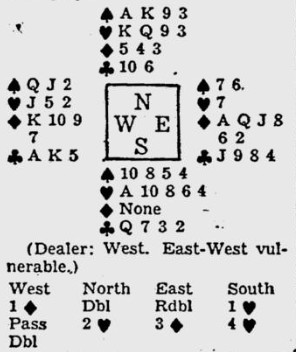St. Petersburg Times – Jan 19, 1948
DON’T get too upset when you and your partner have a misunderstanding. All partnerships have them upon occasion, especially during the auction. The Important thing is to prevent the misunderstanding from damaging the work of your pair on the next or succeeding deals. In fact, it ought to improve your pair by eliminating the likelihood of that particular kind of misunderstanding if a similar situation presents itself again. That is the way such an incident affects the world’s best players.
 Everybody has heard of Oswald Jacoby, who sat West on this deal and Theodore A. Lightner, who was in the East.
Everybody has heard of Oswald Jacoby, who sat West on this deal and Theodore A. Lightner, who was in the East.
Most bridge students also know the name of John R. Crawford. of Philadelphia, one of the most brilliant of the younger championship crop, who was in the South and became the beneficiary of the misunderstanding between his veteran opponents.
Mr. Jacoby thought Lightner’s redouble showed something a bit above an average hand in general high card strength, carrying the extra implication of most such redoubles that if either opponent then made a bid both members of the redoubler’s side «would take a whack at him»—meaning that, if the next one could not double it he would pass to see if his partner wanted to, and if the partner did not want to, be would bid.
Where the misunderstanding came in was that Mr. Lightner thought his bid of 3 diamonds over 2-Hearts, instead of doubling or passing, should have shown his partner that he had only the «fitting» type of re-double without much strength on the side.
But Mr. Jacoby did not so understand it when be doubled the 4 . After the
. After the  2 lead, Mr. Crawford made his doubled game plus an extra trick. Playing West for both missing spade honors, he lost only two tricks in clubs to score a whale of a top score for his pair and team.
2 lead, Mr. Crawford made his doubled game plus an extra trick. Playing West for both missing spade honors, he lost only two tricks in clubs to score a whale of a top score for his pair and team.
